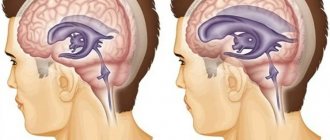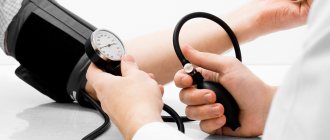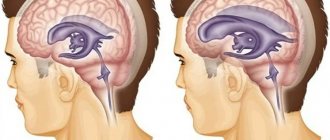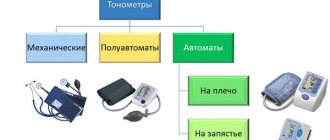The level of blood pressure (BP) in a person is determined by two indicators - upper and lower pressure. The top indicator is scientifically called systolic pressure, and the bottom is diastolic pressure. Together, both indicators show how correctly the heart muscle (myocardium) works, and its normal functioning depends on the work of the large arteries. They are a buffer that prevents the negative influence of external factors on human organs and systems.
After contraction of the cardiac sac, the arterial valve takes a closed position, due to which the flow of blood stops, and the flow of blood from the pulmonary artery, enriched with oxygen, begins. At the next beat, the process changes and blood moves throughout the body. The indicator that is responsible for normal blood flow is the lower, diastolic.
UPPER BLOOD PRESSURE (systolic)
Often at appointments I hear questions and concerns from patients about high and low upper (systolic) pressure, as well as the difference between upper and lower pressure. These questions cause great anxiety and misunderstanding, and sometimes fear.
At each examination, the doctor measures blood pressure, and if the indicators are changed, this is a reason for an in-depth examination. We use tonometers to measure blood pressure at clinic appointments and at home.
These devices are:
– MECHANICAL, that is, when air is pumped into the cuff through a bulb, these are the oldest devices, measuring pressure yourself in this way is not very convenient and the pulse must be calculated independently;
– SEMI-AUTOMATIC – when you pump air manually, and the measurement result is shown on the display,
– AUTOMATIC – when air is pumped automatically. There are blood pressure monitors on the wrist. They are very comfortable and do not create discomfort. But in this case, it is necessary to measure the pressure STRICTLY according to the instructions, otherwise the readings may be unreliable. I had a tonometer from OMRON for a long time; it served me for more than 5 years until I left it on call.
It is important to measure pressure CORRECTLY, otherwise the readings will not be reliable. How to do it?
Dangerous symptoms
A fairly intense, sharp “jump” in downward pressure often develops against the background of a specific cause. This could be an allergic reaction, an acute infectious disease, intoxication of the body, large blood loss, or disruption of the cardiovascular system. In such cases, the person becomes intensely and quickly pale and may lose consciousness. A short-term decrease in pressure gradually returns to normal in a horizontal position. If there is no improvement while lying down, you need to get first aid and try to independently maintain your blood pressure level with the help of medications until the doctors arrive.
- Anticholinergic drugs.
- Medicines that stimulate the central nervous system.
- For acute crises and fainting - alpha-adrenergic agonists.
A sharp increase usually develops against the background of hypertension and requires timely therapeutic intervention - this is taking prescribed medications, calling an ambulance. Few people know that high blood pressure is an extremely dangerous pathology that can lead to dangerous complications.
A “jump” in indicators for hypertension occurs against the background of excessive physical and psychological stress, as a complication of pathologies of the endocrine system and chronic kidney diseases.
With a significant increase in indicators several times, the load on the vessels increases, which often leads to their rupture, and, as a consequence, internal hemorrhage. Most often, such lesions are localized in the retina and brain (hemorrhagic stroke). If your blood pressure increases, it is best to seek professional help.
How to determine high or low blood pressure is one of the pressing issues that almost every person has to face in life. The most effective way to determine indicators is to use a special device (tonometer). But it is not always possible to use this device. In this regard, it is extremely important to know the characteristic features of high and low blood pressure. Since the lack of timely treatment for hypertension can lead to the development of serious complications in the human body, in some cases attacks associated with pressure lead to death.
RULES FOR MEASUREMENT OF BLOOD PRESSURE:
- Sit quietly and sit for 5 minutes;
- Place the cuff on the shoulder 2 fingers above the elbow;
- The cuff should be applied relatively loosely (you can easily place two fingers under the cuff);
- Measure blood pressure;
- Be sure to enter it in a special table in order to track indicators.
We measure blood pressure in the morning and evening. During the day, if necessary. You should not measure your blood pressure more often. If your blood pressure is stable and you feel good, you can monitor it less often. You can periodically monitor the pressure on both hands, especially if there was a difference in the readings before.
Possible consequences of hypertension and hypertension
Arterial hypertension is a short-term violation of the regulatory function of blood pressure, which can lead to a hypertensive crisis and other complications. In the case of frequent or constant increases in blood pressure (hypertension), the load on internal organs and systems increases. If you do not pay attention to the violation in time, it can lead to a heart attack, blockage of blood vessels, heart and kidney failure. The risk of brain hemorrhage increases, memory decreases, performance deteriorates, vision problems arise, etc.
The situation gets worse if the disease is accompanied by risk factors, such as excess weight. Knowing exactly what symptoms are characteristic of hypertension, you can prevent complications and improve the patient’s quality of life.
Advice! It is especially important to periodically measure blood pressure in people who are genetically predisposed to hypertension. If your parents suffered from cardiovascular diseases, then the likelihood of getting sick increases many times over.
HOW TO MONITOR PRESSURE AT HOME?
There is an official diagnostic method - “Home blood pressure monitoring”, when the results of measuring blood pressure in the morning and evening at home are entered into a table. The doctor looks at this table and adjusts the treatment. Such monitoring is especially important for “white coat” hypertension, for latent “anterior hypertension”, when the pressure is high at home but normal at a doctor’s appointment, when prescribing new antihypertensive therapy, or nocturnal hypertension.
Causes of hypertension
High blood pressure is caused by a number of factors. Moreover, a potential or chronic hypertensive patient can eliminate some of them from his life, thereby bringing blood pressure levels closer to normal. Causes of high blood pressure may include the following:
- Heredity.
- Excess salt in the diet (salty foods retain fluid in the body, which causes attacks of hypertension).
- Smoking (nicotine makes blood vessels fragile and deprives them of elasticity).
- Alcohol (alcohol causes a sharp increase in blood pressure, which can lead to a hypertensive crisis).
- Failure to comply with the drinking regime (people who drink a lot of liquid before bed are more likely to experience high blood pressure in the morning, accompanied by swelling).
- Stress (negative emotions cause the release of the hormone adrenaline).
- Physical inactivity (lack of physical activity: the most common cause of hypertension, as it impairs blood flow through the vessels).
- Obesity (excess weight disrupts lipid metabolism, increases the risk of diabetes and cardiovascular disorders).
- Decreased blood glucose concentration.
- Chronic diseases (endocrine, neurogenic, renal, cardiovascular).
- Taking certain medications.
A sudden increase in pressure can be caused by a change in climatic conditions, a change in weather
Gender also plays a role. Hypertension in men most often occurs after 40 years of age. Women traditionally encounter the disease after 50. This is due to the onset of menopause and hormonal changes in the body and increased fragility of blood vessels. Often, women first become acquainted with hypertension during pregnancy, when the load on the circulatory system of the expectant mother increases.
Advice! By eliminating pressure-increasing factors such as smoking, physical inactivity, and excess salt in the diet, you can stop the development of arterial hypertension at an early stage and practically without the use of medications.
BLOOD PRESSURE IS:
– systolic (or upper pressure) – pressure numbers are recorded in the phase when the heart contracts or systole;
– diastolic (or lower pressure) – recorded at the moment of maximum relaxation of the heart, a phase of the heart rhythm called diastole;
– venous;
– capillary.
The last two are measured in a hospital setting and we cannot control them ourselves.
And about medications
Do not self-medicate, do not listen to the advice of friends and neighbors. There are several groups of medications that lower blood pressure, and only a doctor can determine which drug should be taken at the moment.
Hypertension cannot be cured using folk remedies. Follow your doctor's recommendations and take the medications he prescribed for you.
Every Moscow clinic has health centers where you can get doctors’ recommendations on preventing hypertension. Many medical institutions operate schools for patients with arterial hypertension, where qualified specialists explain why hypertension is dangerous and how to treat it.
WHAT IS UPPER PRESSURE (systolic)?
During the phase of maximum contraction of the heart, a wave (push) passes through the vessels; it is recorded on the dial of the tonometer and is heard by the ear as a loud first shock. Then the vessel is gradually released from compression and the very last impulse indicates the lower (diastolic) pressure, which is recorded in the opposite phase of the cardiac cycle.
NORMAL UPPER PRESSURE IN A HUMAN IS 120 mm Hg.
The difference between the upper and lower pressure is PULSE pressure. Normally it is 30 – 50mm (usually 40). If one of the numbers – upper or lower blood pressure – begins to change, then there are reasons to think about your health and get examined.
If the UPPER pressure INCREASES together with the lower pressure, and the difference between these indicators (pulse pressure) does not exceed 50 mmHg. this condition can be defined as HYPERTENSION. It is necessary to undergo examination by a local physician or cardiologist. The initial list of examinations for increased upper and lower blood pressure is determined by standards and recommendations.
Signs of low blood pressure
It is quite important to distinguish high blood pressure from low blood pressure, since hypotension also has a list of symptoms. In addition, the lack of timely help for low blood pressure can lead to serious complications. Hypotension is characterized by a decrease in blood pressure to 100/65 mmHg. Often these indicators are the only sign of physiological hypotension, which is practically asymptomatic.
A person with low blood pressure usually has a thin build and is pale. Hypotension most often affects women at a young age, starting in adolescence.
In other forms of pathology, characteristic signs are observed. One of the very first manifestations is morning dizziness and weakness. With hypotension, a person feels a constant feeling of lethargy, is susceptible to various ailments, and when standing up suddenly, severe dizziness and “darkness” occur in the eyes. In addition, the following symptoms indicate low blood pressure:
- Short-term, regular loss of consciousness. A similar manifestation of low blood pressure occurs among the young age group.
- Attacks of nausea and vomiting are one of the common signs that may indicate high or low blood pressure. It is not recommended to focus only on this factor.
- Cold hands and feet.
- An apathetic state, the manifestation of photosensitivity, decreased performance, a feeling of weakness are some of the most striking components indicating the possible development of hypotension.
It should be noted that such symptoms may indicate the development of other dangerous diseases. Therefore, only a professional doctor can reliably make a diagnosis. In this regard, if such signs appear, it is important to promptly seek help and begin treatment. Advanced hypertension is a serious health risk.
The procedure for determining blood pressure in different categories of patients
In the elderly
This category of people often experiences unstable blood pressure, which is associated with disturbances in the blood flow regulation system, decreased vascular elasticity, and atherosclerosis. Therefore, elderly patients need to take a series of measurements and calculate the average value.
In addition, they need to measure their blood pressure while standing and sitting, since they often experience a sharp drop in blood pressure when changing positions, for example, when getting out of bed and sitting.
In children
It is recommended that children measure blood pressure with a mechanical tonometer or an electronic semi-automatic device, and use a children's cuff. Before measuring your child’s blood pressure yourself, you need to consult with your pediatrician about the amount of air pumped into the cuff and the measurement time.
In pregnant women
Blood pressure can tell you how well your pregnancy is going. For expectant mothers, it is very important to constantly monitor blood pressure in order to start treatment on time and avoid serious complications in the fetus.
During pregnancy, blood pressure monitoring is mandatory
Pregnant women need to measure their blood pressure while reclining. If its level exceeds the norm or, conversely, is much lower, you should immediately consult your doctor.
For cardiac arrhythmia
People who have irregular heartbeat sequence, rhythm and frequency should measure their blood pressure several times in a row, discard clearly incorrect results and calculate the average value. In this case, the air from the cuff must be released at a lower speed. The fact is that with cardiac arrhythmia, its level can vary significantly from beat to beat.
Example of a self-monitoring diary in Excel
If you have constant access to a computer, then filling out the diary can be slightly automated using Excel. For myself, I chose the first option of the self-monitoring diary, inserted a button into it to add readings, which opens a form with the date and time automatically filled in. If necessary, they can be edited both in the form itself and after recording on the worksheet.
Instructions for filling out a blood pressure self-monitoring diary in Excel:
- Click the “Add” button: a form will open with the date and time already filled in.
- Add the tonometer readings to the appropriate fields.
- “Well-being” and “Note” can be selected from the drop-down list*, filled in yourself, or left blank.
- Click the “OK” button and the data from the form will be written to a new row in the table, and the workbook will be saved.
* You can independently specify what data will be shown in the drop-down lists. To do this, simply edit the cell values in the “Wellness” and “Note” columns on the “LD and Appointments” worksheet. The cells of these columns must be filled from top to bottom without gaps.
In the “Note” column you can write:
- presence of arrhythmia;
- medications taken and their dosage;
- body weight, if it is monitored;
- doctor visits;
- other useful information.
It is convenient to move around the form while recording readings using the “Tab” or “Enter” keys. During the transition, the “Well-being” and “Note” fields are skipped, since they are not always filled out.
Interpretation of deviations from the medical norm
Deviations of pressure from the medical norm may be due to:
- Heart failure.
- Blood viscosity. Changes in blood quality are usually felt with changes in lifestyle and nutrition. Thick blood can also be caused by diabetes or an autoimmune system disease.
- Vascular pathology or deterioration in their quality. Excessive loads on the vessels reduce their elasticity, causing the quality of blood circulation to suffer.
- Presence of plaques. The slagging of blood vessels directly affects their patency.
- Hormonal changes that caused a narrowing of the lumen of blood vessels.
- Diseases of the endocrine system.
Interesting historical facts
People have been trying to measure blood pressure since ancient times, before the creation of mercury columns. One of the scientists, Stefan Hales, in the 18th century, decided to establish as an experiment how blood pulsates in a horse’s artery. To do this, he pressed the site of the artery with a rope and attached a glass test tube to it through a metal tube. As a result, the blood showed pulse fluctuations. In this way it was possible to determine the animal's pulse.
The French scientist also conducted his first experiments with animals. In 1928, he used the device for the first time using a mercury column.
And in 1955, they found a way to measure pressure without penetrating the vessel, but by determining the force that is necessary to stop blood circulation. This was made possible with the help of a sphygmograph.
Pressure is measured in the following units - millimeters of mercury. The value consists of two numbers: systolic and diastolic. For a person to feel good, both indicators must be normal. Blood pressure changes with age and also depends on a number of factors. In addition, each person has a “working pressure”, which may not coincide with the norm. It is important to know it and constantly adjust it. At the first signs of hypertension, you should consult your doctor.











